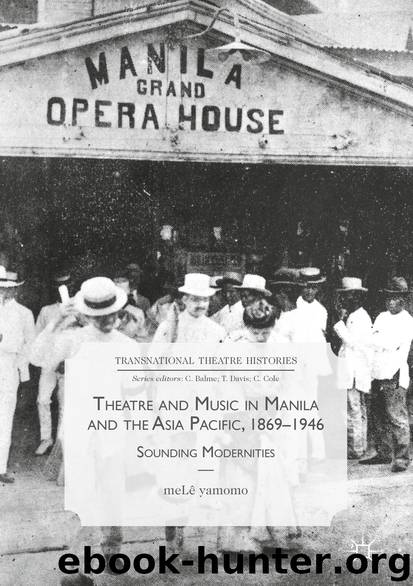Theatre and Music in Manila and the Asia Pacific, 1869–1946 by meLê yamomo

Author:meLê yamomo
Language: eng
Format: epub
ISBN: 9783319691763
Publisher: Springer International Publishing
Modernity and Globalisation
The increased global integration brought about by modern transportation, communication technologies, and the opening of the Suez Canal in 1869, which allowed the fast mobility of people, objects, and ideas across the modernising world, were integrated by tolerant inter-imperial economies. In this period that Eric Hobsbawm calls the Age of Empire 21 and what Christopher Alan Bayly points to as the beginning of the Modern Age is also the era of great migration. This historical juncture is also marked by the high magnitude of concentrated migration of peoples intra- and inter- continentally.
The recent interest in the study of nineteenth-century migration reveals how the movements of labourers between colonial territories give us an idea of the cosmopolitan character of the nineteenth-century cities.22 As sociologist and art historian Anthony D. King argues, the cultural conditions of what we call postmodernity, ‘irony, pastiche, the mixing of different histories, intertextuality, schizophrenia, cultural chasms, fragmentation , incoherence, disjunction of supposedly modern and pre-modern cultures were characteristic of colonial societies, cultures and environments on the global periphery (in Calcutta , Hong Kong, Rio, or Singapore) decades, if not centuries, before they appeared in Europe or the USA’.23 It is from this observation that he proposes the readjustment of our understanding of modernity (and the eventual arrival of postmodernity), from a sequentially conceived cultural process centred in the West towards its spatial, thus global implication.
Recent studies on the relationship of South-east Asian postcolonial history with globalisation take these issues head on. While South-east Asian studies focusing on postcolonial nationalism often emphasise the anti-colonial and nativist strategies taken on by the state in its legitimation, urban studies of the region amplify the role of the South-east Asian cities in the global processes. Aihwa Ong , for example, foregrounds the role of the Asian cities as ‘critical sites in which to inquire into worlding projects, as well as the ongoing result and target of specific worldings’.24 Building on Gayatri Spivak and Rob Wilson’s notion, Ong proposes the idea of ‘worl ding’ as non-ideological ambitious everyday practices ‘that creatively imagine and shape alternative social visions and configurations … [of] an emergent system’25 opposite to the dominant capitalist-laden narrative of globalisation. The idea that postcolonial Asian cities are sites of active practices of globalisation is further historicised by urban scholars Ryan Bishop, John Phillips, and Wei-wei Yeo. In Postcolonial Urbanism: Southeast Asian Cities and Global Processes, they reveal the colonial and postcolonial urban spaces of South-east Asia as intense and multidisciplinary laboratories ‘in which some of the great developments of urban modernity (in anthropology , technology , visual culture , and mass media not least) were developed, to be returned to European and American urban state centers, often in unexpected ways’.26 Looking at the processes involved in the development of the Oxford English Dictionary, fingerprinting practices, modern penal systems, the network system of wiring for the telegraphs , as well as disease and botanical laboratories identifies them as practices first implemented in the colonies before being imported to Europe and the US.
Download
This site does not store any files on its server. We only index and link to content provided by other sites. Please contact the content providers to delete copyright contents if any and email us, we'll remove relevant links or contents immediately.
Call Me by Your Name by André Aciman(20371)
Ready Player One by Cline Ernest(14524)
How to Be a Bawse: A Guide to Conquering Life by Lilly Singh(7391)
Wiseguy by Nicholas Pileggi(5671)
The Kite Runner by Khaled Hosseini(5083)
On Writing A Memoir of the Craft by Stephen King(4863)
Audition by Ryu Murakami(4850)
The Crown by Robert Lacey(4723)
Call me by your name by Andre Aciman(4619)
Gerald's Game by Stephen King(4581)
Harry Potter and the Cursed Child: The Journey by Harry Potter Theatrical Productions(4440)
Dialogue by Robert McKee(4321)
The Perils of Being Moderately Famous by Soha Ali Khan(4169)
Dynamic Alignment Through Imagery by Eric Franklin(4116)
Apollo 8 by Jeffrey Kluger(3637)
Seriously... I'm Kidding by Ellen DeGeneres(3577)
The Inner Game of Tennis by W. Timothy Gallwey(3575)
How to be Champion: My Autobiography by Sarah Millican(3555)
Darker by E L James(3477)
